Related Research Articles
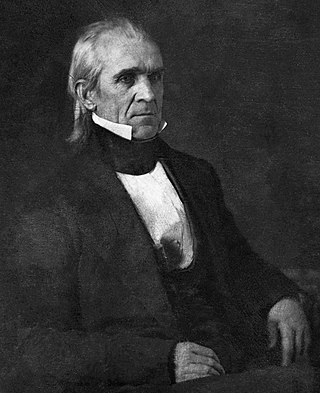
James Knox Polk was the eleventh president of the United States, serving from 1845 to 1849. He also served as the thirteenth speaker of the House of Representatives from 1835 to 1839 and the ninth governor of Tennessee from 1839 to 1841. A protégé of Andrew Jackson, he was a member of the Democratic Party and an advocate of Jacksonian democracy. Polk is known for extending the territory of the United States through the Mexican–American War during his presidency, annexing the Republic of Texas, the Oregon Territory, and the Mexican Cession after winning the Mexican–American War.
The Whig Party was a conservative political party that existed in the United States during the mid-19th century. Alongside the slightly larger Democratic Party, it was one of the two major parties in the United States between the late 1830s and the early 1850s as part of the Second Party System. Four presidents were affiliated with the Whig Party for at least part of their terms. Other prominent members of the Whig Party include Henry Clay, Daniel Webster, Rufus Choate, William Seward, John J. Crittenden, and John Quincy Adams. The Whig base of support was centered among entrepreneurs, professionals, planters, social reformers, devout Protestants, and the emerging urban middle class. It had much less backing from poor farmers and unskilled workers.
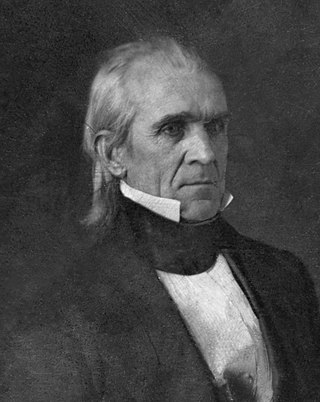
The 1844 United States presidential election was the 15th quadrennial presidential election, held from Friday, November 1 to Wednesday, December 4, 1844. Democrat James K. Polk narrowly defeated Whig Henry Clay in a close contest turning on the controversial issues of slavery and the annexation of the Republic of Texas. This is the only election in which both major party nominees served as Speaker of the House at one point, and the first in which neither candidate held elective office at the time.

Henry Clay Sr. was an American lawyer and statesman who represented Kentucky in both the U.S. Senate and House of Representatives. He was the seventh House speaker as well as the ninth secretary of state. He unsuccessfully ran for president in the 1824, 1832, and 1844 elections. He helped found both the National Republican Party and the Whig Party. For his role in defusing sectional crises, he earned the appellation of the "Great Compromiser" and was part of the "Great Triumvirate" of Congressmen, alongside fellow Whig Daniel Webster and Democrat John C. Calhoun.

Maysville is a home rule-class city in Mason County, Kentucky, United States, and is the seat of Mason County. The population was 8,873 as of the 2020 census. Maysville is on the Ohio River, 66 miles (106 km) northeast of Lexington. It is the principal city of the Maysville Micropolitan Statistical Area, which comprises Mason County. Two bridges cross the Ohio from Maysville to Aberdeen, Ohio: the Simon Kenton Memorial Bridge built in 1931 and the William H. Harsha Bridge built in 2001.

John Bell was an American politician, attorney, and planter who was a candidate for President of the United States in the election of 1860.
Internal improvements is the term used historically in the United States for public works from the end of the American Revolution through much of the 19th century, mainly for the creation of a transportation infrastructure: roads, turnpikes, canals, harbors and navigation improvements. This older term carries the connotation of a political movement that called for the exercise of public spirit as well as the search for immediate economic gain. Improving the country's natural advantages by developments in transportation was, in the eyes of George Washington and many others, a duty incumbent both on governments and on individual citizens.
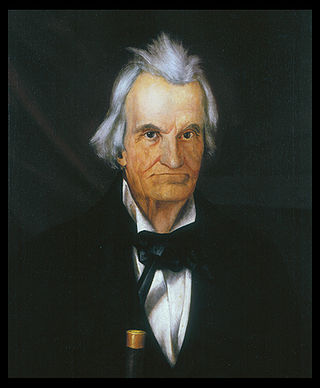
Thomas Metcalfe, also known as Thomas Metcalf or as "Stonehammer", was a U.S. Representative, Senator, and the tenth Governor of Kentucky. He was the first gubernatorial candidate in the state's history to be chosen by a nominating convention rather than a caucus. He was also the first governor of Kentucky who was not a member of the Democratic-Republican Party.

James Turner Morehead was a United States Senator and the 12th Governor of Kentucky. He was the first native-born Kentuckian to hold the governorship of the state. A member of Henry Clay's National Republican Party, Morehead entered politics just as his party was beginning to challenge the Democratic Party's dominance in the state.
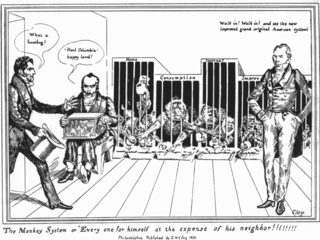
The American System was an economic plan that played an important role in American policy during the first half of the 19th century, rooted in the "American School" ideas of Alexander Hamilton.
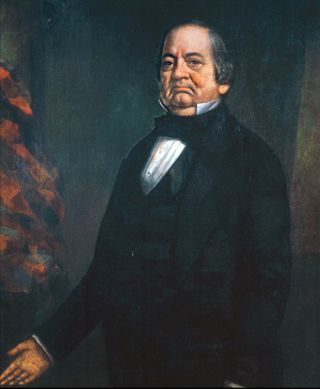
Robert Perkins Letcher was a politician and lawyer from the US state of Kentucky. He served as a U.S. Representative, Minister to Mexico, and the 15th Governor of Kentucky. He also served in the Kentucky General Assembly where he was Speaker of the House in 1837 and 1838. A strong supporter of the Whig Party, he was a friend of Henry Clay and John J. Crittenden.

The presidency of James K. Polk began on March 4, 1845, when James K. Polk was inaugurated as President of the United States, and ended on March 4, 1849. He was a Democrat, and assumed office after defeating Whig Henry Clay in the 1844 presidential election. Polk left office after one term, fulfilling a campaign pledge he made in 1844, and he was succeeded by Whig Zachary Taylor. A close ally of Andrew Jackson, Polk's presidency reflected his adherence to the ideals of Jacksonian democracy and manifest destiny.
Washington is a neighborhood of the city of Maysville located near the Ohio River in Mason County in the U.S. state of Kentucky. It is one of the earliest settlements in Kentucky and also one of the earliest American settlements west of the Appalachian Mountains. It played a significant role in the lead-up to the Civil War, producing two civil war generals and an escaped slave whose legal case established Canada as a safe haven for escaping slaves. It also provided the site where Harriet Beecher Stowe witnessed a slave auction. It has since been annexed by Maysville, and is sometimes now referred to as Old Washington. The community is in Area 606 served by the 759 exchange.
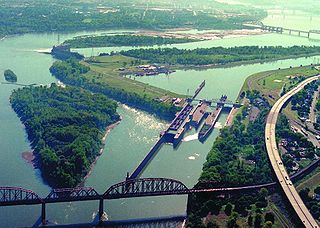
The Louisville and Portland Canal was a 2-mile (3.2 km) canal bypassing the Falls of the Ohio River at Louisville, Kentucky. The Falls form the only barrier to navigation between the origin of the Ohio at Pittsburgh and the port of New Orleans near the Gulf of Mexico; circumventing them was long a goal for Pennsylvanian and Cincinnatian merchants. The canal opened in 1830 as the private Louisville and Portland Canal Company but was gradually bought out during the 19th century by the federal government, which had invested heavily in its construction, maintenance, and improvement.
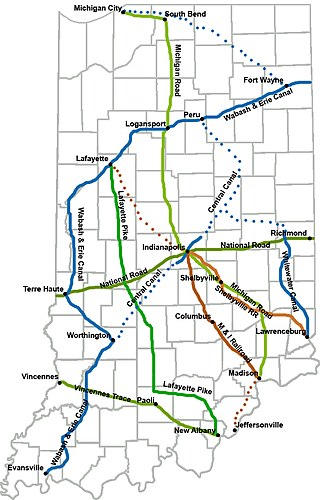
The Indiana Mammoth Internal Improvement Act was a law passed by the Indiana General Assembly and signed by Whig Governor Noah Noble in 1836 that greatly expanded the state's program of internal improvements. It added $10 million to spending and funded several projects, including turnpikes, canals, and later, railroads. The following year the state economy was adversely affected by the Panic of 1837 and the overall project ended in a near total disaster for the state, which narrowly avoided total bankruptcy from the debt.
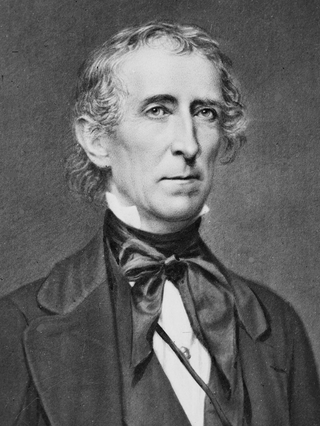
John Tyler was an American politician who served as the tenth president of the United States from 1841 to 1845, after briefly holding office as the tenth vice president in 1841. He was elected vice president on the 1840 Whig ticket with President William Henry Harrison, succeeding to the presidency following Harrison's death 31 days after assuming office. Tyler was a stalwart supporter and advocate of states' rights, including regarding slavery, and he adopted nationalistic policies as president only when they did not infringe on the states' powers. His unexpected rise to the presidency posed a threat to the presidential ambitions of Henry Clay and other Whig politicians and left Tyler estranged from both of the nation's major political parties at the time.
The Rivers and Harbors Bill was a bill passed by Congress in 1846 to provide $500,000 to improve rivers and harbors. When the Senate passed the Rivers and Harbors Bill 34 to 16 on July 24, 1846, opponents lobbied for a presidential veto. It was vetoed by President James K. Polk on August 3. The bill would have provided for federally funded internal improvements on small harbors, many of them on the Great Lakes. Polk believed that this was unconstitutional because the bill unfairly favored particular areas, including that which had no foreign trade.
The Bonus Bill of 1817 was legislation proposed by John C. Calhoun to earmark the revenue "bonus," as well as future dividends, from the recently established Second Bank of the United States for an internal improvements fund. Proponents of the bill stressed the nearly universally accepted need for improvements and brushed off strict constructionists with their own arguments in favor of "implied powers." Although President James Madison approved of the need and stated goals of improvements, he vetoed the bill as unconstitutional because he found no expressed congressional power to fund roads and canals in Article I, Section 8, of the United States Constitution. His veto message represented an important explication by the "Father of the Constitution."
The Chicago River and Harbor Convention of 1847, also known as the Harbor and River Convention of 1847, was a political convention held in Chicago, Illinois, from July 5 to July 7, 1847, to express support for federal funding of internal improvements. Noted for its size and pageantry, the event drew almost 2,500 delegates from nineteen states. Although not expressly partisan in nature, it proved to be important for the elaboration of Whig beliefs.
The history of the United States Whig Party lasted from the establishment of the Whig Party early in President Andrew Jackson's second term (1833–1837) to the collapse of the party during the term of President Franklin Pierce (1853–1857). This article covers the party in national politics. For state politics see Whig Party.
References
- ↑ Glyndon G. Van Deusen, The Jacksonian Era: 1828-1848 (Harper & Brothers, 1959) p. 52
- ↑ Charles M. Wiltse, The New Nation: 1800-1845 (1961) p. 114
- ↑ Congressional Debates, 21st Congress, 1st Session. p. 433-435 (Sen. Tyler). p. 831-833 (Rep. Polk).
- ↑ Congressional Debates, 21st Congress, 1st Session. p. 820 (Rep. Letcher)
- ↑ Congressional Debates, 21st Congress, 1st Session. p. 828 (Rep. Coleman)
- ↑ Congressional Debates, 21st Congress, 1st Session. p. 831 (Rep. Polk)
- ↑ Van Deusen p. 52
- ↑ David P. Currie, The Constitution in Congress: Democrats and Whigs, 1829-1861 (U of Chicago Press, 2005).
- ↑ Michael Holt, The Rise and Fall of the American Whig Party (1999), 232–37